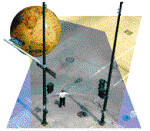Alternate Nations of North America
In my previous post, I mentioned the CommonCensus Map Project. From their website:
The CommonCensus Map Project is redrawing the map of the United States based on your input, to reveal the boundaries people themselves feel, as opposed to the state and county boundaries drawn by politicians. View the maps to see how the country is divided into 'spheres of influence' between different cities at the national, regional, and local levels.
This information will finally settle the question over exactly where cultural boundaries lie, contribute to the national debate over Congressional redistricting and gerrymandering, and educate people everywhere as to the true layout of the American people that they've never seen on any map before.
 This is a fascinating project. Click on this map to see the project as of its last update in August. I live in a suburb of Dayton, generally refer to myself as being from Dayton, but sometimes think of myself as living within the larger sphere of Cincinnatti. In some ways, these areas are analogous to Nielsen Media Markets or Metropolitan Statistical Areas (MSA). But what this project is really about is defining affinities that trancend artificial borders. Which immediately reminds me of The Nine Nations of North America, by Joel Garreau.
This is a fascinating project. Click on this map to see the project as of its last update in August. I live in a suburb of Dayton, generally refer to myself as being from Dayton, but sometimes think of myself as living within the larger sphere of Cincinnatti. In some ways, these areas are analogous to Nielsen Media Markets or Metropolitan Statistical Areas (MSA). But what this project is really about is defining affinities that trancend artificial borders. Which immediately reminds me of The Nine Nations of North America, by Joel Garreau. While it was written in 1989, most of his observations still ring true. Garreau took a look at North America, erased all of the international, state and provincial borders and redrew the lines around regions that have common interests in culture, politics and and industry.
While it was written in 1989, most of his observations still ring true. Garreau took a look at North America, erased all of the international, state and provincial borders and redrew the lines around regions that have common interests in culture, politics and and industry.When I first saw this book, I was naturally attracted by the map on the cover, however, the insights I gained from this book continue to color my understanding of how things work in this country. In this week between the caucuses and primaries, I have a better understanding of what is important to Iowans in the Breadbasket and New Hampshirans in New England.
In the classic alternate history of North America, For Want of a Nail, Robert Sobel allows history to take a different turn.
 Over the two centuries following the failed American Revolution, two rival nations emerge and divide the continet between them. This work of fiction is written as a complete, detailed historical text. The two nations develop on a parallel path that includes some of the best and worst traits of America. According to this article, John J. Reilly described them as two strands of American nationalism, "the utopian impulse, resulting in a penchant for social reform" and "quixotic experiments in economic equality," that is "very keen on liberty and indifferent to equality".
Over the two centuries following the failed American Revolution, two rival nations emerge and divide the continet between them. This work of fiction is written as a complete, detailed historical text. The two nations develop on a parallel path that includes some of the best and worst traits of America. According to this article, John J. Reilly described them as two strands of American nationalism, "the utopian impulse, resulting in a penchant for social reform" and "quixotic experiments in economic equality," that is "very keen on liberty and indifferent to equality". Labels: alternate history, imaginary countries, north america, united states





0 Comments:
Post a Comment
Subscribe to Post Comments [Atom]
<< Home